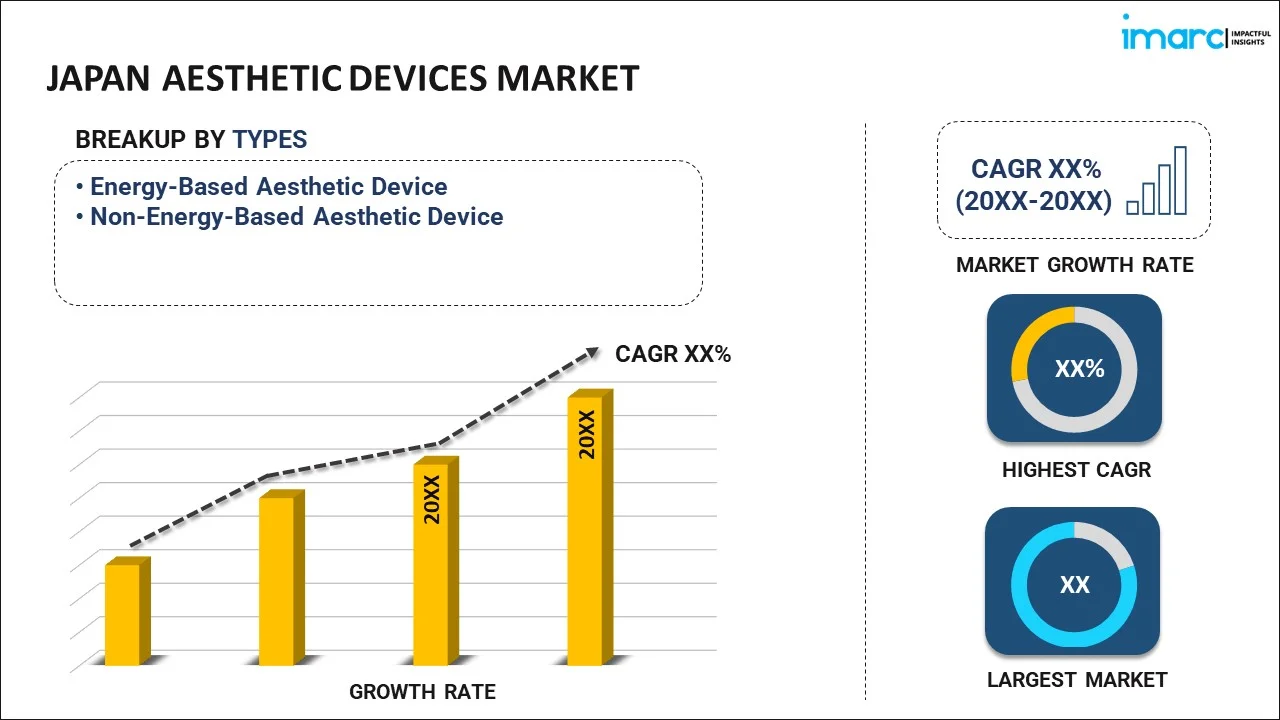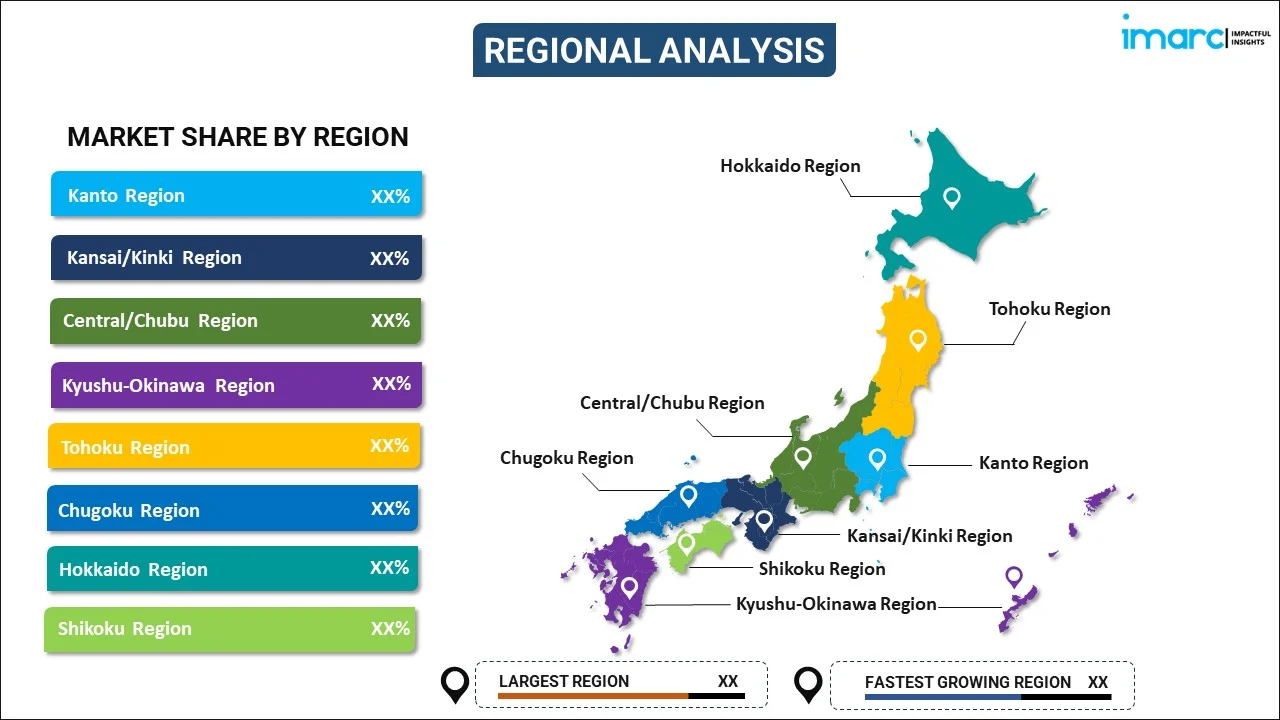
Japan Aesthetic Devices Market Report by Type (Energy-Based Aesthetic Device, Non-Energy-Based Aesthetic Device), Application (Skin Resurfacing and Tightening, Body Contouring and Cellulite Reduction, Hair Removal, Facial Aesthetic Procedures, Breast Augmentation, and Others), End User (Hospital, Aesthetic Centers, Home Settings), and Region 2025-2033
Market Overview:
Japan aesthetic devices market size reached USD 930 Million in 2024. Looking forward, IMARC Group expects the market to reach USD 2,290 Million by 2033, exhibiting a growth rate (CAGR) of 10.5% during 2025-2033. The increasing consciousness among consumers towards their physical appearances, along with the growing influence of social media platforms, is primarily driving the market growth.
|
Report Attribute
|
Key Statistics
|
|---|---|
|
Base Year
|
2024
|
|
Forecast Years
|
2025-2033
|
|
Historical Years
|
2019-2024
|
|
Market Size in 2024
|
USD 930 Million |
|
Market Forecast in 2033
|
USD 2,290 Million |
| Market Growth Rate 2025-2033 | 10.5% |
Aesthetic devices are specialized equipment designed for cosmetic treatments that enhance, alter, or rejuvenate physical appearances. They serve various purposes, offering solutions ranging from skin tightening and resurfacing to body contouring and hair removal. Aesthetic devices find wide-ranging applications, primarily in dermatological and cosmetic clinics, for numerous non-invasive to minimally invasive procedures that address a multitude of aesthetic concerns, such as wrinkles, excess fat, cellulite, and unwanted hair. They also offer several advantages, including precision, efficacy, reduced recovery times, etc., as compared to traditional surgical methods. These devices provide a spectrum of treatment options, allowing for personalized aesthetic care and meeting individual needs and preferences with minimized risk and discomfort. They enable practitioners to provide advanced treatment modalities, allowing users to achieve desired aesthetic outcomes with optimal safety. They facilitate the administration of treatments with increased accuracy and predictability, boosting patient satisfaction and confidence.
Japan Aesthetic Devices Market Trends:
The Japan aesthetic devices market is experiencing significant growth, on account of the continuous technological advancements designed to improve skincare routines. A predominant factor is the rising demand for non-invasive or minimally invasive aesthetic procedures, owing to their minimal downtime and reduced risk. Additionally, the growing awareness among individuals towards personal grooming, coupled with the aging demographic seeking age-reversal treatments, is acting as another significant growth-inducing factor. Besides this, the increasing emphasis on beauty and physical appearance, influenced by societal and cultural factors, is further catalyzing the utilization of aesthetic devices. Moreover, a surge in medical tourism is also evident, with Japan becoming a sought-after destination for aesthetic treatments, drawing individuals seeking quality and innovative cosmetic solutions. The regional market is witnessing the rise of multifunctional devices that offer diverse treatment options, meeting the varying needs of consumers effectively. Furthermore, the widespread adoption of laser-based treatments and the development of portable product variants are other trends reflecting the ongoing transformations. This, in turn, is anticipated to fuel the Japan aesthetic devices market over the forecasted period.
Japan Aesthetic Devices Market Segmentation:
IMARC Group provides an analysis of the key trends in each segment of the market, along with forecasts at the country level for 2025-2033. Our report has categorized the market based on type, application, and end user.
Type Insights:

To get more information on this market, Request Sample
- Energy-Based Aesthetic Device
- Laser-Based Aesthetic Device
- Radiofrequency (RF) Based Aesthetic Device
- Light-Based Aesthetic Device
- Ultrasound-Based Device
- Non-Energy-Based Aesthetic Device
- Botulinum Toxin
- Dermal Fillers and Aesthetic Threads
- Microdermabrasion
- Implants
The report has provided a detailed breakup and analysis of the market based on the type. This includes energy-based aesthetic device (laser-based aesthetic device, radiofrequency (RF) based aesthetic device, light-based aesthetic device, and ultrasound-based device) and non-energy-based aesthetic device (botulinum toxin, dermal fillers and aesthetic threads, microdermabrasion, and implants).
Application Insights:
- Skin Resurfacing and Tightening
- Body Contouring and Cellulite Reduction
- Hair Removal
- Facial Aesthetic Procedures
- Breast Augmentation
- Others
A detailed breakup and analysis of the market based on the application have also been provided in the report. This includes skin resurfacing and tightening, body contouring and cellulite reduction, hair removal, facial aesthetic procedures, breast augmentation, and others.
End User Insights:
- Hospital
- Aesthetic Centers
- Home Settings
A detailed breakup and analysis of the market based on the end user have also been provided in the report. This includes hospital, aesthetic centers, and home settings.
Regional Insights:

- Kanto Region
- Kansai/Kinki Region
- Central/ Chubu Region
- Kyushu-Okinawa Region
- Tohoku Region
- Chugoku Region
- Hokkaido Region
- Shikoku Region
The report has also provided a comprehensive analysis of all the major regional markets, which include Kanto Region, Kansai/Kinki Region, Central/ Chubu Region, Kyushu-Okinawa Region, Tohoku Region, Chugoku Region, Hokkaido Region, and Shikoku Region.
Competitive Landscape:
The market research report has also provided a comprehensive analysis of the competitive landscape. Competitive analysis such as market structure, key player positioning, top winning strategies, competitive dashboard, and company evaluation quadrant has been covered in the report. Also, detailed profiles of all major companies have been provided. Some of the key players include:
- AbbVie Inc.
- Cutera Inc.
- Cynosure Inc.
- Lumenis Be Ltd.
- Sciton Inc.
- Venus Concept Inc.
(Please note that this is only a partial list of the key players, and the complete list is provided in the report.)
Japan Aesthetic Devices Market News:
- March 2025: At the 40th Korea International Medical & Hospital Equipment Show (KIMES 2025) held in Seoul, South Korea, Gilsung Su, Director at Ltra Global, unveiled the improved Bellasonic 2X Plus, highlighting its increased dependability and internal development. The updated model offered various ultrasound frequencies (3MHz and 10MHz) and consisted of reengineered handpieces that could address sensitive areas like the under-eye and nose. The firm revealed plans to broaden its distributor network in Japan, Indonesia, Myanmar, and Turkey. It sought to create a significant advantage in the ultrasound-driven aesthetic device sector by integrating enhanced technology and user-friendliness.
- January 2025: Shonan Beauty Clinic unveiled its proprietary translation app designed for medical aesthetics personnel and the comprehensive roll-out of its ‘Inbound-Focused Clinics’ program. This innovative initiative aimed to meet the rising demand for medical tourism and guaranteed that overseas patients could effortlessly access Japan's advanced aesthetic medical treatments.
Japan Aesthetic Devices Market Report Coverage:
| Report Features | Details |
|---|---|
| Base Year of the Analysis | 2024 |
| Historical Period | 2019-2024 |
| Forecast Period | 2025-2033 |
| Units | Million USD |
| Scope of the Report | Exploration of Historical and Forecast Trends, Industry Catalysts and Challenges, Segment-Wise Historical and Predictive Market Assessment:
|
| Types Covered |
|
| Applications Covered | Skin Resurfacing and Tightening, Body Contouring and Cellulite Reduction, Hair Removal, Facial Aesthetic Procedures, Breast Augmentation, Others |
| End Users Covered | Hospital, Aesthetic Centers, Home Settings |
| Regions Covered | Kanto Region, Kansai/Kinki Region, Central/ Chubu Region, Kyushu-Okinawa Region, Tohoku Region, Chugoku Region, Hokkaido Region, Shikoku Region |
| Companies Covered | AbbVie Inc., Cutera Inc., Cynosure Inc., Lumenis Be Ltd., Sciton Inc., Venus Concept Inc., etc. |
| Customization Scope | 10% Free Customization |
| Post-Sale Analyst Support | 10-12 Weeks |
| Delivery Format | PDF and Excel through Email (We can also provide the editable version of the report in PPT/Word format on special request) |
Key Benefits for Stakeholders:
- IMARC’s industry report offers a comprehensive quantitative analysis of various market segments, historical and current market trends, market forecasts, and dynamics of the Japan aesthetic devices market from 2019-2033.
- The research report provides the latest information on the market drivers, challenges, and opportunities in the Japan aesthetic devices market.
- Porter's five forces analysis assist stakeholders in assessing the impact of new entrants, competitive rivalry, supplier power, buyer power, and the threat of substitution. It helps stakeholders to analyze the level of competition within the Japan aesthetic devices industry and its attractiveness.
- Competitive landscape allows stakeholders to understand their competitive environment and provides an insight into the current positions of key players in the market.
Key Questions Answered in This Report
The aesthetic devices market in Japan was valued at USD 930 Million in 2024.
The Japan aesthetic devices market is projected to exhibit a CAGR of 10.5% during 2025-2033, reaching a value of USD 2,290 Million by 2033.
An aging population seeking anti-aging solutions, coupled with younger generations pursuing beauty enhancement, is fueling the adoption of aesthetic devices. Advancements in laser technology, radiofrequency, and ultrasound-based devices are improving safety, precision, and recovery times. An increasing number of beauty clinics, medical spas, and dermatology centers is expanding service accessibility.
Some of the major players in the Japan aesthetic devices market include AbbVie Inc., Cutera Inc., Cynosure Inc., Lumenis Be Ltd., Sciton Inc., Venus Concept Inc., etc.
Need more help?
- Speak to our experienced analysts for insights on the current market scenarios.
- Include additional segments and countries to customize the report as per your requirement.
- Gain an unparalleled competitive advantage in your domain by understanding how to utilize the report and positively impacting your operations and revenue.
- For further assistance, please connect with our analysts.
 Request Customization
Request Customization
 Speak to an Analyst
Speak to an Analyst
 Request Brochure
Request Brochure
 Inquire Before Buying
Inquire Before Buying




.webp)




.webp)












